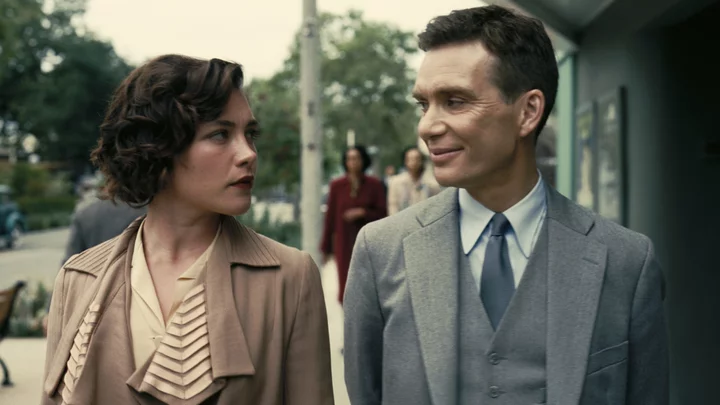Oppenheimer may be the first time Christopher Nolan has made a biographical drama, but it also marks another huge milestone for the director: This is his first film featuring sex scenes.
It's nearly impossible for a movie to feature a sex scene nowadays without igniting some grand discourse, including the dreaded "sex scenes serve no purpose" talking point. Nolan's first foray into onscreen sex is no different. Even before the film's release, its sex scenes have already been the subject of several articles. An early reaction from The Telegraph critic Robbie Collin proved particularly intriguing, as he proclaimed the scenes as being "sex as only Nolan could stage it."
So what does it mean for sex to be quintessentially "Nolan" — especially since his films have often been criticized as sexless? Does it mean we can expect stylistic Nolan trademarks like intense crosscutting or mind-boggling visual set pieces? Are Oppenheimer viewers in for rotating hallway, wormhole circling, time inverting sex?
Not as such. Oppenheimer features two sex scenes, both between J. Robert Oppenheimer (Cillian Murphy) and Jean Tatlock (Florence Pugh). And while they don't feature any timey-wimey shenanigans, the sequences speak to many of Nolan's sensibilities as a filmmaker, including his fixation on philosophy and theory, his penchant for the surreal, and his unfortunate tendency to portray women as tragic figures in the orbit of male genius.
SEE ALSO: 'Oppenheimer' review: Ambitious, deeply Nolan, deeply flawedNolan brings a religious text to Oppenheimer's first sex scene.
Florence Pugh and Cillian Murphy in "Oppenheimer." Credit: Melinda Sue Gordon/Universal PicturesFor all the fuss that's been made about it, there isn't much actual sex in Oppenheimer's first sex scene. Instead, the focus becomes a Sanskrit book Tatlock finds on Oppenheimer's shelf. (Yes, on top of his work in the field of theoretical physics, Oppenheimer was learning Sanskrit.) The book is the Bhagavad Gita, a key religious text in Hinduism as well as a part of the epic poem, the Mahabharata. According to a 1948 Time article, Oppenheimer enjoyed reading the text to his friends, and he kept a Scotch tape-patched copy in his office at Princeton.
In the film, Tatlock asks Oppenheimer to read her a passage from the Bhagavad Gita as they start having sex again, and of course, he alights on the passage that Oppenheimer would later say came to mind when he witnessed the first-ever detonation of a nuclear weapon. In it, Prince Arjuna, overlooking a battlefield, asks Lord Krishna to assume his supreme form. He does so, then says, as quoted by Oppenheimer, "Now I am become Death, the destroyer of worlds."
The mid-sex scene placement of such an impactful line, one forever intertwined with Oppenheimer's legacy, is unusual, but very Nolan. His films often concern themselves with the philosophy of morality: The Dark Knight even offers up a giant-sized version of the prisoner's dilemma with its ferry sequence. So if you were to tell me a famed director somehow wove the Bhagavad Gita, with its own discussions of morality and duty, into a sex scene, the first one to come to mind would be Nolan.
SEE ALSO: The 'Oppenheimer’ cast on shooting the film's most remarkable momentsHowever, just because the scene reads as Nolan-esque doesn't mean it's entirely effective. For one, the sex between Tatlock and Oppenheimer is cold and almost passionless (more classic Nolan critiques), to the point that we don't truly get a sense of their relationship. The incorporation of the Bhagavad Gita here is more awkward than anything, an absurd "look, he said the line!" moment rather than an actual beat where we get to understand two characters' intimacy.
That it's Tatlock who urges Oppenheimer to translate Sanskrit for her during sex also speaks to one of Nolan's greatest flaws across his films: his treatment of women as vessels for his male leads' genius. Tatlock is frustratingly underdeveloped throughout Oppenheimer, with her opening flirtations limited to spouting Communist theory and her final scenes reducing her to a tortured mistress. In the film's first sex scene, her insistence that Oppenheimer read to her does not come across as Tatlock making the (strange) choice to bring the Bhagavad Gita to bed. Instead, it feels like Oppenheimer shoehorning a key quote into the film early on, with Tatlock serving as the best vehicle to do so.
Oppenheimer's second sex scene is more surreal — and still unsatisfying in its treatment of women.
Emily Blunt and Cillian Murphy in "Oppenheimer." Credit: Melinda Sue Gordon/Universal PicturesWhile Oppenheimer's first sex scene is "sex as only Nolan could stage it" on a more thematic level, the film's second sex scene feels truer to Nolan in a formal sense. As Oppenheimer participates in a security hearing, with the United States Atomic Energy Commission picking apart his former Communist ties, his interrogators grill him over the last time he saw Tatlock. First, the scene cuts to a hotel room, where the two sit across from each other in separate armchairs, both completely naked, but with legs crossed, giving some modesty to the scene. Naturally, they spend this nude moment mostly talking about Oppenheimer's work.
When we cut back to the hearing, we see Oppenheimer completely undressed as the proceedings continue. It's a stark stylistic turn, perhaps a visual representation of his personal life being literally laid bare by the proceedings. Yet that interpretation changes when a naked Tatlock materializes atop Oppenheimer, wiggling her hips as he continues to address the board before him. Through slow pans between Tatlock and Oppenheimer's wife Kitty (Emily Blunt), sitting in the corner of the hearing, both looking directly into the camera, we realize the scene is what Kitty is envisioning as the board picks apart her husband's affair.
The injection of a fearful vision into an otherwise sterile government boardroom echoes the surreal nightmares of Inception's dream sequences. This is Kitty's subconscious rearing its head in the face of stress and humiliation. It is one of the only times in the film we get her perspective on a situation. More than that, the moment where she makes eye contact with an enraptured Jean is truly the closest two women ever get to speaking to each other in Oppenheimer — outside of a single line tossed Kitty's way by a party hostess. Jean once again becomes a vessel, this time for Kitty's own qualms about her marriage.
Like Jean, Kitty is under-served in this moment. Wives in Nolan films tend to exist in one category — dead. So the fact that she is alive makes for a nice change of pace. However, Kitty still falls into the trope of "tragic" wife. Her emotional journey revolves around her husband: whether he'll survive the Trinity Test, whether he'll escape the hearing unscathed, and whether his affairs will continue to hurt their family. It's the last that materializes in this surreal sex scene.
Oppenheimer's boardroom moment is neither sexy nor trying to be, but both it and the Bhagavad Gita-quoting sequence are as Nolan as a sex scene can get. And while he makes bold thematic and stylistic choices in each, Nolan's examination of Oppenheimer's relationships through sex remains frustratingly surface-level. The simple fact that onscreen sex even exists in a Nolan movie winds up feeling more impactful than the content of the scenes themselves.
Sure, Oppenheimer himself may have loved sex, but the film most certainly does not.









